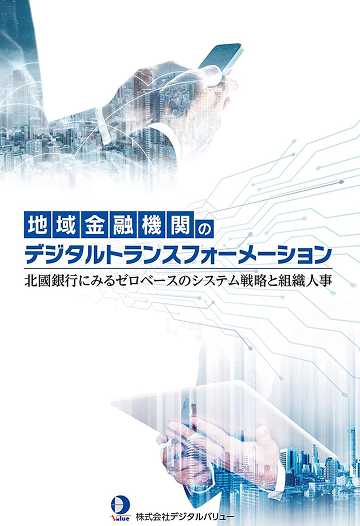Book Details
Digital Transformation in Regional Financial Institutions
-

- This summary has been generated using AI.This book documents Hokkoku Bank’s digital transformation journey—not as a simple shift to IT, but as a fundamental reimagining of how a regional financial institution operates. From system independence and cloud migration to talent development, agile practices, and the creation of a regional financial ecosystem, each chapter presents concrete examples of how the bank is evolving to meet future challenges.
- Published in 2021
Chapter 1: Rethinking System Strategy and Building Independence
Hokkoku Bank made a strategic decision to move away from outsourcing its systems, which had been the norm since the early 2000s. Instead, it began developing and operating systems in-house. This shift was not just about reducing costs—it was about responding more quickly to customer needs, improving development quality, and strengthening organisational autonomy. Through projects such as cloud migration and internet banking development, the bank cultivated a culture of “building it ourselves.” This transition required a major mindset shift among employees and became a driving force for broader organisational change.
Chapter 2: Cloud Migration and Embracing Open Systems
The bank’s migration of core systems—including accounting platforms—to Microsoft Azure involved a phased transition from IaaS to PaaS. Challenges such as VM errors and cloud-specific operational issues were overcome through close collaboration with Microsoft. Over 100 subsystems are being consolidated and internalised, with xRM used to balance flexibility and cost efficiency. Operating banking services in the cloud is not just a technical upgrade—it’s a strategic foundation for enhancing competitiveness. Benefits include improved security, scalability, and availability, all of which support future regional collaboration and ecosystem development.
Chapter 3: Talent Development and Cultural Change
To build technical capabilities, the bank partnered with KIT for graduate recruitment and used platforms like paiza for mid-career hiring. Internships led by younger employees and hackathons focused on cloud AI are among the many hands-on initiatives. A flat communication culture supported by Microsoft Teams has taken root, fostering psychological safety and openness. This environment has accelerated development speed and quality, energising the organisation. IT education is also extended to non-technical staff, raising digital literacy across the bank.
Chapter 4: Agile Development and Cross-Functional Collaboration
Agile development has enabled staff from business departments to participate actively in projects after receiving training. Tools like inception decks and trade-off sliders help clarify goals and priorities. CI/CD and automated testing have improved both speed and quality. With business and IT teams working as one, the bank has become more responsive to customer needs. A culture of “fail fast and recover quickly” has emerged, encouraging experimentation. Agile is not just a methodology—it’s a catalyst for organisational transformation.
Chapter 5: Building a Regional Financial Ecosystem
Hokkoku Bank aims to share cloud-based software with other regional financial institutions and connect data across municipalities, schools, and healthcare providers. By 2024, over 90% of subsystems will be cloud-based, and core systems will transition to PaaS, prompting a complete rethink of development structures and methods. The vision of building a cloud-based financial infrastructure for the region goes beyond banking—it contributes to revitalising local communities. Through BaaS (Banking as a Service), API integration, and AI applications, the bank is creating flexible services that meet diverse regional needs and generate value beyond traditional finance.
